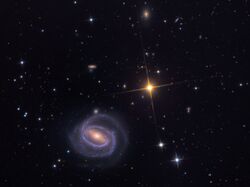Astronomy:NGC 266
| NGC 266 | |
|---|---|
 NGC 266 is the galaxy in the center-left of this photo. The bright star in the center is SAO 54174. | |
| Observation data (J2000 epoch) | |
| Constellation | Pisces |
| Right ascension | 00h 49m 47.81400s[1] |
| Declination | +32° 16′ 39.8067″[1] |
| Redshift | 0.015547[2] |
| Helio radial velocity | 4,565.3±15.3[3] km/s |
| Distance | 197 Mly (60.3 Mpc)[4] |
| Apparent magnitude (V) | 12.54[2] |
| Characteristics | |
| Type | SB(rs)ab[4] |
| Apparent size (V) | 3.0' × 2.9'[2] |
| Other designations | |
| UGC 00508, CGCG 501-022, MCG +05-03-009, 2MASX J00494779+3216398, 2MASXi J0049479+321639, IRAS 00471+3200, F00470+3200, PGC 2901.[2] | |
NGC 266 is a massive[4] barred spiral galaxy in the constellation Pisces. NGC 266 is located at a distance of 197 megalight-years from the Milky Way.[4] It was discovered on September 12, 1784, by William Herschel.[5] The form of this barred galaxy is described by its morphological classification of SB(rs)ab,[4] which indicates a quasi-ring-like structure (rs) and moderate-to-tightly wound spiral arms (ab). It is the dominant member of a small group with six low-mass galaxies.[4]
NGC 266 is an LINER-type active galaxy.[6] It has a moderate star formation rate estimated at 2.4 M☉·yr−1.[4] A diffuse X-ray emission from hot gas has been detected around this galaxy, extending out to a radius of at least 70,000 light years. This emission not being driven by winds from a starburst region, so the root cause is unknown.[4]
On October 12, 2005, a magnitude 16.8 supernova was discovered in NGC 266. It was positioned 29.8″ east and 16.7″ north of the galactic nucleus. An image of the galaxy taken on September 10 showed no supernova event, so this explosion occurred after that date.[7] This event was designated SN 2005gl, and the progenitor was identified as a massive hypergiant star that was most likely a luminous blue variable.[8]

References
- ↑ 1.0 1.1 Brown, A. G. A. (August 2018). "Gaia Data Release 2: Summary of the contents and survey properties". Astronomy & Astrophysics 616: A1. doi:10.1051/0004-6361/201833051. Bibcode: 2018A&A...616A...1G. Gaia DR2 record for this source at VizieR.
- ↑ 2.0 2.1 2.2 2.3 "NASA/IPAC Extragalactic Database". Results for NGC 0266. http://ned.ipac.caltech.edu/cgi-bin/objsearch?objname=NGC+266&extend=no&hconst=73&omegam=0.27&omegav=0.73&corr_z=1&out_csys=Equatorial&out_equinox=J2000.0&obj_sort=RA+or+Longitude&of=pre_text&zv_breaker=30000.0&list_limit=5&img_stamp=YES.
- ↑ van den Bosch, Remco C. E. et al. (May 2015). "Hunting for Supermassive Black Holes in Nearby Galaxies With the Hobby-Eberly Telescope". The Astrophysical Journal Supplement Series 218 (1): 13. doi:10.1088/0067-0049/218/1/10. 10. Bibcode: 2015ApJS..218...10V.
- ↑ 4.0 4.1 4.2 4.3 4.4 4.5 4.6 4.7 Bogdán, Ákos et al. (August 2013). "Detection of a Luminous Hot X-Ray Corona around the Massive Spiral Galaxy NGC 266". The Astrophysical Journal 772 (2): 5. doi:10.1088/0004-637X/772/2/98. 98. Bibcode: 2013ApJ...772...98B.
- ↑ "New General Catalog Objects: NGC 250 - 299". Cseligman. http://cseligman.com/text/atlas/ngc2a.htm#266.
- ↑ "NGC 266". SIMBAD. Centre de données astronomiques de Strasbourg. http://simbad.u-strasbg.fr/simbad/sim-basic?Ident=NGC+266.
- ↑ Puckett, T. et al. (October 2005). D. W. E., Green. ed. "Supernova 2005gl in NGC 266". Central Bureau Electronic Telegrams 250: 1. Bibcode: 2005CBET..250....1P.
- ↑ Gal-Yam, A.; Leonard, D. C. (April 2009). "A massive hypergiant star as the progenitor of the supernova SN 2005gl". Nature 458 (7240): 865–867. doi:10.1038/nature07934. PMID 19305392. Bibcode: 2009Natur.458..865G.
External links
 |

